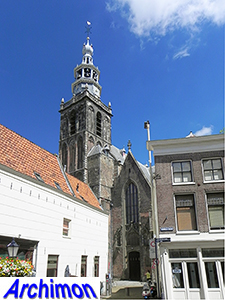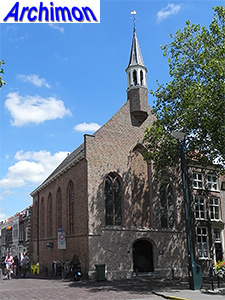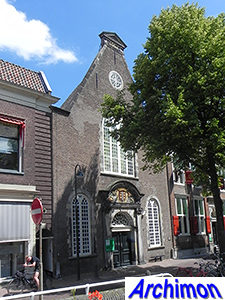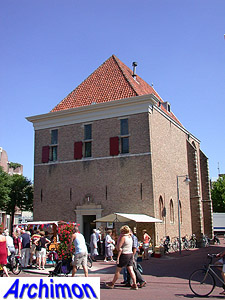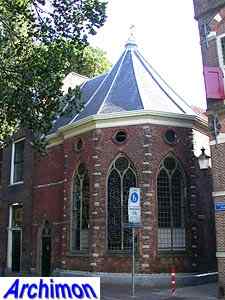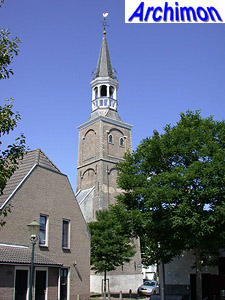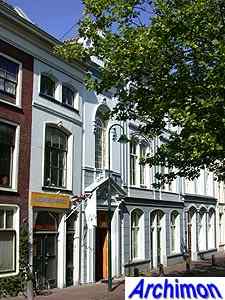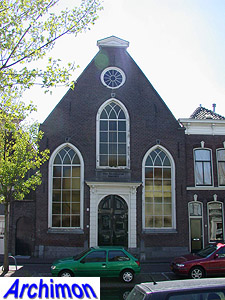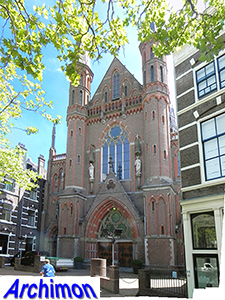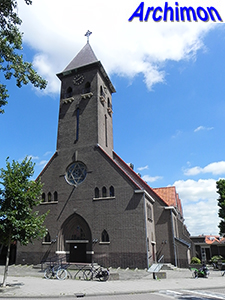 Gouda werd gesticht in de 12de eeuw en kreeg stadsrechten in 1272. De stad bloeide als handelscentrum tot de 16e eeuw, ondanks het feit dat zij door branden in 1361 en 1438 werd verwoest. Na de Reformatie ging de economie achteruit, en de stad werd uiteindelijk een van de armste in de provincie Holland. In de loop van de 20e eeuw groeide de welvaart van de stad, en vele historische gebouwen werden opgeofferd in het kader van de vooruitgang. Niettemin heeft Gouda vandaag de dag nog steeds veel goed bewaarde historische gebouwen. De stad Gouda is tevens een gemeente die verder geen andere plaatsen omvat. |
|
The Gothic St. Jan, still called that even though it has been a protestant church for over 400 years, is Gouda's major church. With a length of 123 metres it is also the longest church in The Netherlands. It was built in the course of the 5th century, when it replaced a 13th-century church. First a three-aisled hall-church, it eventually grew to become a wide cruciform basilica. Location: Achter de Kerk 1 De gotische St. Jan, zoals de kerk nog steeds genoemd wordt hoewel zij al meer dan 400 jaar een protestantse kerk is, is Gouda's belangrijkste kerk. Met een lengte van 123 meter is het ook de langste kerk van Nederland. Zij werd gebouwd in de loop van de 15de eeuw, toen zij een 13e eeuwse kerk verving. Na aanvankelijk te zijn opgezet als een driebeukige hallenkerk, groeide zij uiteindelijk uit tot een brede kruisbasiliek. Locatie: Achter de Kerk 1
|
|
The St. Joostkapel is a small Gothic chapel that was built in ca. 1425 and has been used as a Lutheran church since 1682. In 1869 it was rebuilt in neo-Gothic style, but during a restoration in 1957 its Gothic state was reconstructed. Location: Lage Gouwe 134 De St. Joostkapel is een kleine gotische kapel die werd gebouwd rond 1425 en die sinds 1682 is gebruikt als Lutherse kerk. In 1869 werd zij verbouwd in neogotische stijl, maar tijdens een restauratie in 1957 werd de gotische toestand gereconstrueerd. Locatie: Lage Gouwe 134
|
|
The Gasthuiskapel was the chapel of the St. Catharina hospital and was built in 1474. The current facade in Classical style dates from 1665. After 1610 it served as a protestant church and today it is part of a museum. Location: Oosthaven 9-10 De Gasthuiskapel was de kapel van de St. Catharinagasthuis en werd gebouwd in 1474. De huidige gevel in classicistische stijl dateert uit 1665. Vanaf 1610 diende het als protestantse kerk, en tegenwoord is het onderdeel van een museum. Locatie: Oosthaven 9-10
|
|
The Agnietenkapel is the former chapel and the only remaining part of the St. Agnes convent. It was built in the 15th century and in 1631, after the Reformation, was drastically remodelled for profane use. Location: Nieuwe Markt 100 De Agnietenkapel is de voormalige kapel en het enige resterende deel van het St. Agnesconvent. Zij werd gebouwd in de 15e eeuw en werd in 1631, na de Reformatie, drastisch verbouwd voor profaan gebruik. Locatie: Nieuwe Markt 100
|
|
The Jeruzalemkapel is a small Gothic chapel with twelve sides, built in ca. 1500 by commission of a priest after his return from a pilgrimage to the Holy Grave in Jerusalem. Only a part of the original chapel remains; a rectangular space has been demolished. Location: Jeruzalemstraat 12 De Jeruzalemkapel is een kleine gotische kapel met een twaalfzijdige plattegrond, gebouwd rond 1500 in opdracht van een priester na zijn terugkeer van een bedevaart naar het Heilig Graf in Jeruzalem. Slechts een deel van de oorspronkelijke kapel is behouden; een rechthoekig bouwdeel is gesloopt. Locatie: Jeruzalemstraat 12
|
|
The O.L.Vrouwetoren ('Our Lady's tower') was the tower of the O.L. Vrouwekapel, which was built in 1493 and demolished in 1585. The tower was renovated in 1754 and clad with a new coat of bricks. Location: Vrouwesteeg 34 De O.L.Vrouwetoren was de toren van de OL Vrouwekapel, die werd gebouwd in 1493 en gesloopt in 1585. De toren werd gerenoveerd in 1754 en toen bekleed met een nieuwe laag bakstenen. Locatie: Vrouwesteeg 34
|
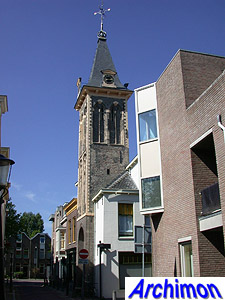 Another lone tower is the late-Gothic Barbara tower which was built as part of the St. Barbara chapel in 1505. The actual chapel was demolished in 1581. Location: Kuiperstraat 42 Een andere losse toren is de laat-gotische Barbaratoren die in 1505 werd gebouwd als onderdeel van de St. Barbarakapel. De eigenlijke kapel werd gesloopt in 1581. Locatie: Kuiperstraat 42 |
|
The Old-Catholic church St. Jan Baptist was founded in 1630 as a Roman Catholic clandestine church, standing hidden behind a house. In 1632 a new church was built. Shortly after 1732 the church became Old-Catholic. In 1863 it was enlarged and given the current plastered facade in Eclectic style. Location: Hoge Gouwe 107 De Oud-Katholieke kerk St. Jan Baptist werd in 1630 gesticht als een rooms-katholieke schuilkerk, verborgen gelegen achter een huis. In 1632 werd een nieuwe kerk gebouwd. Kort na 1732 werd de kerk Oud-Katholiek. In 1863 werd zij nogmaals uitgebreid en kreeg zij de huidige gepleisterde gevel in eclectische stijl. Locatie: Hoge Gouwe 107
|
|
The synagogue was founded in
1798, first using a former Lutheran clandestine church. In 1827 a new synagogue
was built, a building in neo-Classical style. After World War Two, which
decimated the Jewish community, the building became an evangelical church.
Location: Turfmarkt 23 De synagoge werd gesticht in 1798
en maakte eerst gebruik van een voormalige Lutherse schuilkerk. In 1827 werd een nieuwe synagoge gebouwd, een gebouw in neoclassicistische stijl. Na de Tweede Wereldoorlog, die de Joodse gemeenschap
had gedecimeerd, werd het gebouw een evangelische kerk. Locatie: Turfmarkt 23
|
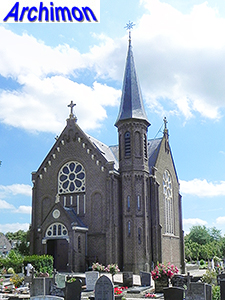 The chapel of the catholic cemetery is a building in neo-Romanesque style, designed by local architect C.P.W. Dessing and built in 1890-1891. Location: Graaf Florisweg 126a De kapel van de katholieke begraafplaats is een bouwwerk in neoromaanse stijl, ontworpen door de plaatselijke architect C.P.W. Dessing en gebouwd in 1890-1891. Locatie: Graaf Florisweg 126a |
|
The neo-Gothic St. Jozef or Gouwekerk or was built as the second catholic church in the center, after the O.L.V. Hemelvaart which was demolished in 1964. The church, the tallest building in the center due to its crossing-tower, was designed by C.P.W. Dessing and built in 1902-1904. It was closed as a catholic church in 1972, and from 1979 until 2018 it served as an evangelist church. Location: Hoge Gouwe 41 De neogotische St. Jozef of Gouwekerk werd gebouwd als de tweede katholieke kerk in het centrum, na de O.L.V. Hemelvaart, die werd afgebroken in 1964. De kerk, het hoogste gebouw in het centrum dankzij de vieringtoren, werd ontworpen door C.P.W. Dessing en gebouwd in 1902-1904. Zij werd in 1972 buiten gebruik gesteld als katholieke kerk, en diende van 1979 tot 2018 als een evangelistische kerk. Locatie: Hoge Gouwe 41
|
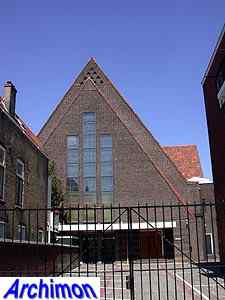
The Gereformeerde kerk was built
in moderate Expressionist style in 1931-1932. This style at that time was
usual for churches of this denomination. It was designed by J.
Groenendijk. This church was demolished in 2018. De Gereformeerde kerk werd gebouwd in een gematigd expressionistische stijl in 1931-1932. Deze stijl was in die tijd gebruikelijk voor kerken van dit kerkgenootschap. Het gebouw werd ontworpen door J. Groenendijk. De kerk werd in 2018 gesloopt. Locatie: Turfmarkt 60 |
|
The catholic H. Sacrament is an aisleless church in Traditionalist style, designed by J.P. Dessing and built in 1931-1932 to serve the catholics in the part of Gouda south of the old town. The church was closed in 2004 and was transformed into a health center in 2006-2008. Location: Jacob van Lennepkade 3 De katholieke H. Sacrament is een eenbeukige kerk in traditionalistiusche stijl, ontworpen door J.P. Dessing en gebouwd in 1931-1932 ten behoeve van de katholieken in het gedeelte van Gouda ten zuiden van het centrum. De kerk werd in 2004 gesloten en is in 2006-2008 verbouwd tot gezondheidscentrum. Locatie: Jacob van Lennepkade 3 |
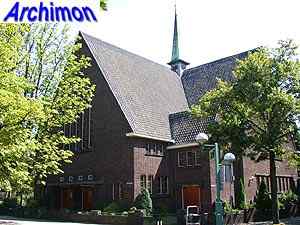
Architect C.M. Wijnhoven designed
the Oranjekerk of the Gereformeerde Gemeente in the same style. This church was
built in 1936. Architect C.M. Wijnhoven ontwierp de Gereformeerde Gemeentekerk in dezelfde stijl. Deze kerk werd gebouwd in 1936. Locatie: Stationsplein 17 |
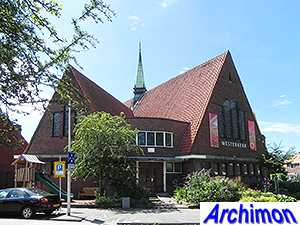 The reformed Westerkerk was built in 1936 in the south of Gouda. It's a centralising church in Expressionist style, designed by D. Stuurman. Location: Emmastraat 33 De hervormde Westerkerk werd in 1936 gebouwd in het zuiden van Gouda. Het is een centraliserende kerk in expressionistische stijl, ontworpen door D. Stuurman. Locatie: Emmastraat 33 |
|
|
